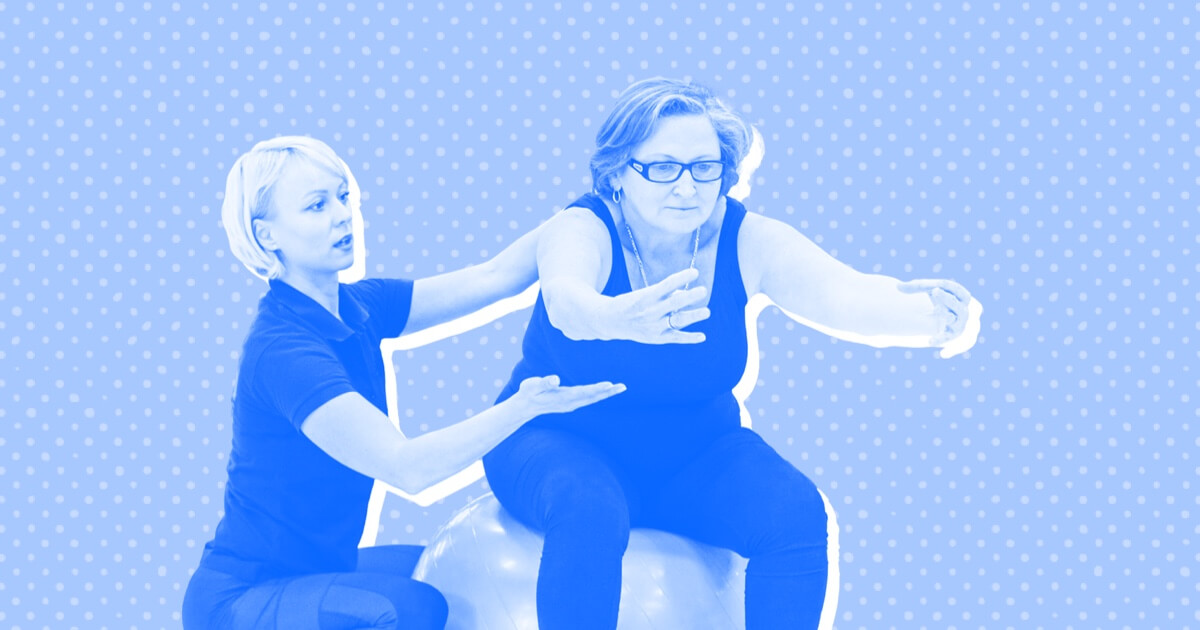Our population is getting older. While this may sound like a no-brainer, the rate at which our population is aging is something to think about. Consider these facts about our population trajectory:
- In 2019, 16% of the U.S. population was aged 65 or older – that’s 54.1 million Americans
- The number of Americans aged 65 + will more than double over the next 40 years, reaching 80 million in 2040
- The number of adults ages 85 and older will almost quadruple between 2000 and 2040
Health and wellness programs have long been proven to help improve quality of life for advanced age adults. But what does that look like in practice?
What does our fitness journey look like?
In our early to mid-adulthood, our fitness focus will look very different from our late-adulthood ideals. At 25 or 35 you might be looking to run a marathon or squat your bodyweight, vs. at 65 or 75 where your focus will likely be on maintaining an independent lifestyle.
That’s not to say that 65-year olds can’t run marathons – they do. In fact, the nine oldest marathon runners range in age from 87 to 102! But for the general population, activities of daily living (ADLs) become a key focus in our fitness journey. Something we don’t think about, like putting on a shoe or reaching high in a cabinet, can become more difficult and potentially dangerous as we age.
Aging isn’t a disease
No one actually dies of old age. But as we age, our risk factors for chronic disease and complications increase. Our bodies become less able to fight infection and more prone to injury. Exercise has long been a tactic to maintain a physical body that is less susceptible to disease or injury.

As we age, our cells die. This process, called apoptosis, typically ends with the dead cell being removed from our body. As we age, our ability to flush the dead cells declines. We then find ourselves with something called senescent cells. These are cells that have stopped multiplying but don’t die and are not removed by apoptosis. Lingering senescent cells can actually damage other healthy cells nearby.
All this is to say that aging is a complicated process with plenty of research being conducted into how we can slow damage and reduce chronic illness as we get older. Our best course of action is doing whatever we can to get healthy and stay healthy.
How do we define fitness after 65?
The word ‘fitness’ is often loaded, especially in today’s highly saturated world of so-called wellness trends that are often diet culture masquerading as something else. For those over 65, ADLs are often used as an evaluation tool for health purposes. There are also more general categories of fitness. The Center for Disease Control (CDC) looks at five components when assessing individual fitness:
- Aerobic capacity
- Muscular strength
- Muscular endurance
- Flexibility
- Body composition
Most fitness directives for older populations focus on flexibility, balance, and muscular strength as these three factors directly relate to ADLs. For adults over 65, the CDC recommends:
- 150+ minutes a week of moderate intensity activity such as brisk walking. Or 75 minutes a week of vigorous-intensity activity such as hiking, jogging, or running
- 2+ days a week of activities that strengthen muscles
- Activities to improve balance such as standing on one foot about 3 days a week
Why bone density matters
Until age 25, our bodies break down and create new bone material, so our bone density increases. From 25 to 50, our bone density stays roughly the same. After 50, our bone density starts to decrease.
Our bones lose density as we age, so strength is one of the most important areas of focus for fitness throughout someone’s life. Falls are a major threat for the elderly population, therefore weak or brittle bones only add to the danger from a fall. Fitness plans that focus on strength can help prevent severe damage from a fall.
If you’re in your mid-adulthood, fear of falling may not be something that taxes your mind on a daily basis, but for some older populations, it’s a very real issue. A study on osteoporosis and the fear of falling concluded that it negatively impacted people’s daily lives.
What does this mean for personal trainers?
All personal trainers should have a working knowledge of the various populations they can commonly encounter – prenatal clients, older clients, and clients with chronic conditions. For those who want to specialize more specifically, there are certifications that provide more focus.
The National Strength and Conditioning Association offers a Certified Special Population Specialist® (CSPS) certification which focuses on people with both chronic and acute health conditions. These can include:
- Diabetes
- Advanced age
- Post-partum
- Fibromyalgia
- Cancer
- Asthma
Both the ACE and NASM fitness organizations offer specializations in senior fitness. While these are not full credentials like a Certified Personal Trainer, they are add-on specializations that show an individual’s area of focus.
In general, people are living longer. This means there’s a big population of adults who will need to maintain their independence and mobility later in their life. Personal trainers are going to be an important part of helping people maintain their health.
A healthy older population is much bigger than keeping grandma blowing out the birthday candles. The financial impact of putting older adults into long-term care can devastate families. Removing someone from their home can have severe psychological impacts. Simply put, keeping the older population as healthy and functional as possible is important for our overall population health.
Most common exercises for 65+
As mentioned earlier, strength and balance are two areas of focus for those 65 and up. So do we have them go straight to the squat rack? If they’ve been routinely using a squat rack and are comfortable, sure, but for most older adults, this is not where to start.
Evaluation of ADLs, flexibility, and mobility are where most trainers will start. Can your client easily get up from a seated position? Can they comfortably reach above their head and pull something off a shelf?
Resistance training has proven to increase muscle strength. One study showed that after twelve weeks of resistance training, women with fibromyalgia increased their strength and in turn reduced their symptoms.
Squats are one of the most popular movements (for good reason). It ensures a client can comfortably squat their own body weight before moving on to adding weights. This might be easy for someone in their 60s, but less so for someone in their 90s. A modification could include sitting into a chair and standing, with moderate help from a counter.
Resistance bands are also helpful due to their ease and range of use. Many exercises can be performed seated in a chair (rows or bicep curls) or standing (lateral raises, lunge with bicep curl).
Our bodies go through major changes as we age. As long as we’re prepared, it’s often possible to maintain strength, endurance, and flexibility well into our later years.

